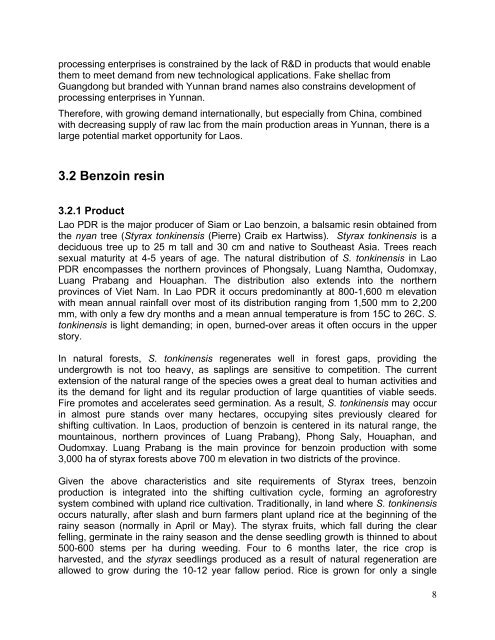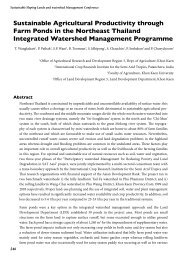Cross-border NTFP value chains Laos – China - nafri
Cross-border NTFP value chains Laos – China - nafri
Cross-border NTFP value chains Laos – China - nafri
Create successful ePaper yourself
Turn your PDF publications into a flip-book with our unique Google optimized e-Paper software.
processing enterprises is constrained by the lack of R&D in products that would enable<br />
them to meet demand from new technological applications. Fake shellac from<br />
Guangdong but branded with Yunnan brand names also constrains development of<br />
processing enterprises in Yunnan.<br />
Therefore, with growing demand internationally, but especially from <strong>China</strong>, combined<br />
with decreasing supply of raw lac from the main production areas in Yunnan, there is a<br />
large potential market opportunity for <strong>Laos</strong>.<br />
3.2 Benzoin resin<br />
3.2.1 Product<br />
Lao PDR is the major producer of Siam or Lao benzoin, a balsamic resin obtained from<br />
the nyan tree (Styrax tonkinensis (Pierre) Craib ex Hartwiss). Styrax tonkinensis is a<br />
deciduous tree up to 25 m tall and 30 cm and native to Southeast Asia. Trees reach<br />
sexual maturity at 4-5 years of age. The natural distribution of S. tonkinensis in Lao<br />
PDR encompasses the northern provinces of Phongsaly, Luang Namtha, Oudomxay,<br />
Luang Prabang and Houaphan. The distribution also extends into the northern<br />
provinces of Viet Nam. In Lao PDR it occurs predominantly at 800-1,600 m elevation<br />
with mean annual rainfall over most of its distribution ranging from 1,500 mm to 2,200<br />
mm, with only a few dry months and a mean annual temperature is from 15C to 26C. S.<br />
tonkinensis is light demanding; in open, burned-over areas it often occurs in the upper<br />
story.<br />
In natural forests, S. tonkinensis regenerates well in forest gaps, providing the<br />
undergrowth is not too heavy, as saplings are sensitive to competition. The current<br />
extension of the natural range of the species owes a great deal to human activities and<br />
its the demand for light and its regular production of large quantities of viable seeds.<br />
Fire promotes and accelerates seed germination. As a result, S. tonkinensis may occur<br />
in almost pure stands over many hectares, occupying sites previously cleared for<br />
shifting cultivation. In <strong>Laos</strong>, production of benzoin is centered in its natural range, the<br />
mountainous, northern provinces of Luang Prabang), Phong Saly, Houaphan, and<br />
Oudomxay. Luang Prabang is the main province for benzoin production with some<br />
3,000 ha of styrax forests above 700 m elevation in two districts of the province.<br />
Given the above characteristics and site requirements of Styrax trees, benzoin<br />
production is integrated into the shifting cultivation cycle, forming an agroforestry<br />
system combined with upland rice cultivation. Traditionally, in land where S. tonkinensis<br />
occurs naturally, after slash and burn farmers plant upland rice at the beginning of the<br />
rainy season (normally in April or May). The styrax fruits, which fall during the clear<br />
felling, germinate in the rainy season and the dense seedling growth is thinned to about<br />
500-600 stems per ha during weeding. Four to 6 months later, the rice crop is<br />
harvested, and the styrax seedlings produced as a result of natural regeneration are<br />
allowed to grow during the 10-12 year fallow period. Rice is grown for only a single<br />
8



